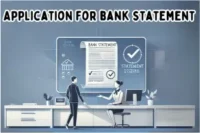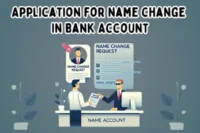Application for Opening a Bank Account: Steps, Example & Formats
Published: 4 May 2025
A bank account is essential for safely storing money, making payments, and earning interest. The application for opening a bank account is simple and involves choosing the correct type, providing the necessary documents, and completing an application form. It’s a quick and easy process that helps manage your finances effectively.
What is a Bank Account Application?
A bank account application is a form you fill out to open a bank account. This form collects personal details such as your name, address, and identification information. It helps the bank understand who you are to provide you with the right banking services, like depositing money, transferring funds, and using ATMs.
For example, “When you want to open a bank account, you must complete an application. This process helps the bank know your information and allows you to use its services.”
Have you ever wondered how to start a bank account? It’s easier than you think! All it takes is a few simple steps, and you’ll be able to manage your money easily. Ready to get started? Let’s dive into the process!

How to Fill Out the Bank Account Opening Application
Here’s a clear, simple breakdown of how to fill out a bank account opening application following your steps:
Step 1: Choose the Type of Account (Current, Savings, etc.)
- What to do: Decide what kind of account you want to open. Most banks offer different types, like
- Savings Accounts, are great for saving money and earning interest.
- Current Account: Ideal for regular transactions and day-to-day banking.
- Fixed Deposit Account: Suitable for those who want to lock their money for a higher interest rate.
- Tip: Consider your financial goals and pick the account that fits your needs.
Step 2: Provide Personal Details (Name, Date of Birth, etc.)
- What to do: Fill in basic personal information such as your full name (as proof of your identity).
- Your date of birth.
- Your gender (sometimes optional).
- Nationality (if required).
- Example: It’s like filling out your details on a form at a doctor’s office, where they need to know who you are.
Step 3: Enter Contact Information (Phone Number, Email)
- What to do: Add your contact details so the bank can reach you. This includes
- Your phone number.
- Your email address (so you can receive account-related notifications).
- Tip: Double-check your contact details to avoid missing any critical updates from the bank.
Step 4: Submit Proof of Identity and Address
- What to do: The bank must verify your identity and residential address. You must provide
- Proof of identity, such as your passport, driver’s license, or government-issued ID.
- Proof of Address: This might be a utility bill, lease agreement, or bank statement that shows your current address.
- Example: It’s like showing your ID and a recent bill to confirm who you are and where you live.
Step 5: Choose Banking Services (ATM card, internet banking, etc.)
- What to do: Depending on your needs, you may be asked to choose from various banking services like
- ATM/Debit Card For easy access to your funds.
- Internet banking: To manage your account online.
- Mobile banking: For banking through your phone.
- Chequebook: If you want to write checks.
- Tip: Choose the services that will make your banking more convenient and match your lifestyle.
Example:
Just like filling out a simple form, you’ll be asked for basic info like your name, address, and which services you want with your new account. For example, you might say, “I want to open a savings account, provide my ID and proof of address, and receive an ATM card.”
By following these simple steps, you’ll have your request to open a bank account processed and your account set up in no time!
Application for Opening a Bank Account
Opening a bank account is often the first step towards managing your finances effectively. Whether you’re saving for the future or need a safe place for your salary, filling out an application is essential to access the many services a bank offers.
To,
The Manager,
[Insert Name of the Bank]
[Insert Address of the Bank]
Subject: Request for Opening a Current Account
Respected Sir,
I hope this letter finds you well. I am requesting the opening of a [type of account: savings/current] account with your esteemed bank. I have heard about the various services and benefits your bank provides, and I am keen to avail myself of these services.
I am submitting the documents required for the account opening process, including my proof of identity, address proof, and passport-sized photographs, per the bank’s requirements. Kindly let me know if any additional documents or formalities are needed.
Please process my application as soon as possible. If any further information is required, please get in touch with me via my phone number or email.
Thank you for your time and consideration. I look forward to your response.
Yours faithfully,
[Your Name]
You can use this application by simply replacing the details with your information, such as your name, address, and the type of account you wish to open. This makes the process quick and easy and ensures your application is tailored to your personal needs.
Formal Application for Opening a Bank Account
When an individual decides to open a bank account—whether for personal savings, salary deposits, or daily transactions—a formal application to the bank becomes the first essential step. It is an official request that initiates the account opening process and verifies your intent.
To
The Branch Manager,
[Bank Name],
[Branch Address].
Subject: Application for Opening a [Savings/Current] Bank Account
Respected Sir/Madam,
I am writing to formally request the opening of a [Savings/Current] account in my name at your branch. I have enclosed all the necessary documents, including my identity proof, address proof, and recent passport-sized photographs.
Kindly process my request at your earliest convenience. I shall be thankful for your kind assistance.
Thanking you,
Yours faithfully,
[Your Full Name]
[Contact Number]
[Date]
This application can be easily customized by replacing placeholders like [Bank Name], [Branch Address], and [Savings/Current] with your specific details. To make your request effective, attach clear copies of required documents, keep the tone formal, and ensure no spelling or factual errors—small things that help speed up approval.
Common Mistakes to Avoid When Filling Out the Application
When completing your bank account opening application, it’s important to be thorough and precise. Small errors or missing documents can cause unnecessary delays.
1. Incomplete or Incorrect Information
Always double-check your details, such as your name, date of birth, and contact information. Small mistakes can cause delays or rejection of your application.
2. Not Providing Correct Documents
Ensure that all the documents you submit are current and valid. Missing or outdated documents can slow down the processing time.
Example:
Sarah forgot to submit her proof of address, which caused a delay in
By avoiding these common mistakes, you can ensure a smooth application process. Double-checking your information and documents will help speed up the approval of your bank account. Processing her application.
Benefits of Having a Bank Account
Opening a bank account isn’t just about saving money—it’s about gaining access to critical financial tools. Whether you’re a student, worker, or business owner, the benefits can make everyday life much easier.
- 1. Security
- A bank account helps protect your money, as it’s insured and much safer than keeping cash at home. Banks also use strong security systems to prevent theft and fraud.
- 2. Easy Access to Services
- With a bank account, you can easily transfer money, pay bills, and withdraw cash anytime using ATMs or mobile apps.
- Tip: It saves time and gives you 24/7 access to your funds.
- 3. Building a Financial History
- A bank account helps you build a good financial history and is useful when applying for loans, credit cards, or even renting a home.
- Example: Regular account activity shows responsibility and builds trust with banks.
- 4. Safe Savings and Interest Earnings
- Banks offer a safe place to keep your savings; many accounts also earn interest over time.
- Tip: Even small deposits can grow steadily with good saving habits.
- 5. Access to Credit and Loans
- With a bank account, applying for personal loans, credit cards, or home loans is easier.
- Example: Banks are more likely to approve customers who maintain an active account.
- 6. Easy Record-Keeping
- Bank accounts provide monthly or digital statements to help track your spending and income.
- Tip: This helps with budgeting and financial planning.
As you can see, having a bank account offers security and convenience. It’s a smart step toward managing your finances and planning for a better future.
Conclusion
Opening a bank account is a simple process, but it requires careful attention to detail to ensure everything goes smoothly. By following the steps correctly and submitting the required documents, your account will be up and running quickly. 🏦
Final Tips for a Successful Application
To make the process as seamless as possible, here are a few tips:
- Double-check your details: Make sure all the information you provide is accurate. A small mistake could delay the process. ✔️
- Ensure you have all the required documents: Bring the necessary identification and proof of address documents. Check with your bank beforehand to make sure you have everything you need. 📄
- Don’t rush through the form: Carefully fill out the application form, as rushing might lead to errors or missing information. 📝
Encourage Action
Now that you know the steps and tips for opening a bank account, it’s time to take action! Head to your nearest bank branch or visit their website to get started on your application. Good luck with your bank account opening! 🚀💳
Frequently Asked Questions About Opening a Bank Account
Here are some common questions people ask before opening a bank account. These answers will help you understand the process better and prepare the proper documents.
The amount required to open a bank account depends on the type of account and the bank’s policies. Some banks may require a minimum deposit for a savings account, while others may offer zero-balance accounts. A current (business or individual) account typically requires a larger initial deposit than savings accounts. Speciality accounts, like student or minor accounts, may require no deposit. Always check with your specific bank for the exact requirements, as they can vary by location and account type.
To open a bank account, you generally need the following documents:
- Proof of Identity (e.g., National ID, Passport, Driver’s License).
- Proof of Address (e.g., Utility bill, Bank statement).
- Photographs (passport-sized).
- Proof of Income (e.g., Payslip, Tax return) if applicable.
- Completed Account Opening Form and Signature Proof.
Additional documents may be required for business, joint, or minor accounts. Always check with the specific bank for its requirements.
There is generally no fixed limit on how many accounts a person can open at a bank, but it depends on the bank’s policies. Typically, you can open multiple types of accounts, such as:
- Multiple Savings Accounts – Some banks may allow more than one savings account, while others may limit it.
- Current Accounts – You can usually open more than one, especially if they are for business purposes.
- Joint Accounts – You can have joint accounts with different people.
- Speciality Accounts – You might open different accounts for specific purposes (e.g., student, minor, or business).
Banks may have specific conditions or requirements for opening multiple accounts, and you may need to maintain certain balances or prove a legitimate reason for each account. Always check with your bank for their rules.
Opening a typical bank account takes 1 to 3 working days after you submit all the required documents. Some banks offer instant account opening through online services or digital KYC verification. However, the process may take longer if any missing papers or further verification is required. Due to extra formalities and approvals, it might take additional time for current or business accounts. It’s best to check with your chosen bank for their exact processing time.
Many banks now offer the option to open a bank account online. However, depending on the bank’s policy and the type of account, you may still need to visit the branch once for identity or document verification.
Filling out a bank account application form is easy. Follow a few simple steps and provide accurate information.
- Step 1: Choose the type of account you want to open (Savings, Current, etc.).
- Step 2: Fill in your details like full name, date of birth, and gender.
- Step 3: Enter your contact details, such as phone number and email address.
- Step 4: Attach valid documents for identity and address proof.
- Step 5: Select the banking services you want (ATM card, chequebook, internet/mobile banking).
Example: It’s like filling out a simple form—you must provide basic personal info and choose your preferred services.
We hope these answers clear your doubts about opening a bank account. It is always best to contact your chosen bank for any specific requirements.





